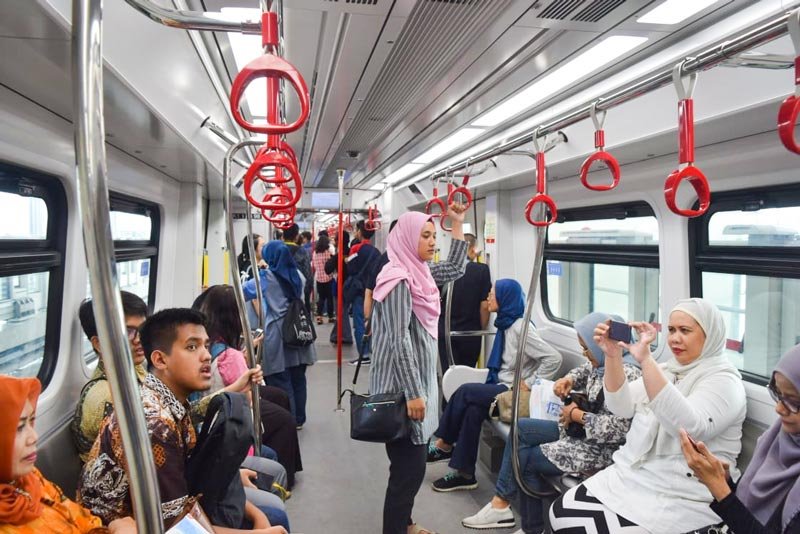I still remember the days where I have to chase after the Kopaja bus that heading to Slipi which after that I would continue by taking a smaller car to reach my campus. Number 88 is the bus number if it is still the same as many years ago. Usually, there are two guys on board – one is the bus driver and another one is the ‘kenek’, the guy who get the passengers in and collect payments. With one hand holding on the handle near to the bus door and another hand grabbing some notes while waving the crowds to board the bus, that is a very normal scene in Jakarta.
“Kalideres! Kalideres! Kalideres!
Slipi! Slipi! Slipi!”
To date, with more than 260 millions of population in Jakarta, we clearly know that relying solely on buses and microbuses in this big city is no longer a sufficient solution. Instead, we find that the traffic jam is getting worse from year to year. Stressful days over the traffic in Jakarta seems no end. Even there is a saying that people who reside in Jakarta get old on the road.
Read:
Resolving the Road Traffic Issue in Jabodetabek #AyoNaikBus
Visitation to MRT Jakarta: Bundara HI Station

Fortunately, starting last April 2019, besides the public big and small buses, we now have the MRTJ train as alternative transportation. MRTJ (Mass Rapid Transit Jakarta) targets to carry 760.000 passengers daily by 2030. If this target met, road traffic is definitely will be getting better. Less car on the road which also means less pollution in Jakarta. Not only that, after the launching of MRTJ, now we shall look forward to the launching of LRTJ.
TABLE OF CONTENTS
LRT Jakarta
LRTJ stands for Light Rail Transit Jakarta. The name itself has obviously explained that it is the lighter version of MRT. LRTJ is targetted to carry around 14.500 passengers daily.

The Differences between MRT and LRT
LRT has a much smaller capacity compared to MRT. Each MRTJ can have more than five wagons, usually six, and each wagon can take up to about 322 passengers. Meanwhile, for LRT usually only has between two to four wagons each and each wagon can take up to 132 passengers. Besides that, MRT runs underground and on the elevated track above the ground while LRT only the latter. Because of the lesser wagons and the size as well, LRT can move more flexible and smooth on a winding track than MRT can. That is also because LRT moves slower than MRT that can go from 80 km/hour up to 100 km/hour while LRT is from 40 km/hour up to 80 km/hour the max.


Type of LRT and the Differences
There are two types of LRT which often mistaken as one same thing. One is LRT Jabodebek and another one is LRT Jakarta (LRTJ). LRT Jabodebek is operated by PT KAI (Kereta Api Indonesia) and it connects Jakarta to a few major areas around Jakarta such as Bekasi and Cibubur. While LRTJ is operated by PT LRT Jakarta, the sub-company of Jakpro which percentage of the investment belongs to DKI Jakarta provincial government. As of now, LRTJ only runs in Kelapa Gading area, North of Jakarta.
The current LRTJ track is about 5.8 km long, laid between Pegangsaan Dua to Velodrome, and has 6 stations in total which are Pegangsaan Dua, Boulevard Utara, Boulevard Selatan, Pulomas, Equis and Velodrome. In the future, they will expand the track further to Tanah Abang which is located in Central of Jakarta. Imagine the amount of time and stress that LRTJ will help the commuter to save from the bad traffic if they were to travel from Kelapa Gading to Tanah Abang with the current land transportation.
The LRTJ Fare

Flat rate IDR5,000,-. Yes, that is the flat rate applied for taking LRTJ. Whether you board on LRTJ and alight one stop later or alight at the last stop, the cost you pay is the same IDR5,000,- Probably they will be some adjustment on the fare later on but for now, as this article is written, that is the fare that we were informed.
Likewise to MRTJ, to take LRTJ, we can purchase a single trip ticket or get the season pass if we are daily commuters. Or if we are not and we don’t want to waste time lining up for the single trip ticket, we can always pay using our Flazz, E-money or card that we usually use to pay for taking TransJakarta. Just that we have to make sure that we have values stored on our card then tap and go! Easy peasy lemon squeezy, peeps!
• • •
In the end, the target from all the efforts made is to integrate all these different modes of public transportation in Jakarta such as TransJakarta, Commuter Line, Grab, and Gojek, MRT and LRT, into one connecting line that can transfer the commuters from one transportation to another in a smoother way. A pleasant journey for the commuters in Jakarta is what we all are looking for, aren’t we?

Although since I moved back to Jakarta I never took the Kopaja again but until now I still remember vividly how the ‘kenek’ called to reach out the passengers. After hearing him shouting daily for years, it is kind of stuck in my head already. I was ‘brain-washed’! However, on the other side, I am glad that I was born in an era where I can see all the changes and transitions happening.
Let’s start taking public transportation as often as we can! By doing so, it is not only more cost-efficient, but we are also helping to reduce the traffic, pollution and bring what we dream about Jakarta – to have a better transportation solution like other countries have, comes to a realization one step sooner. And I can’t wait to see that day to come.







